Assessing the Worth of a 200 Carat Diamond
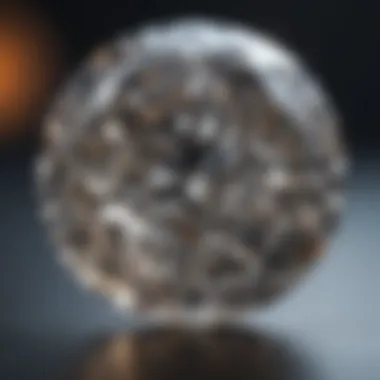
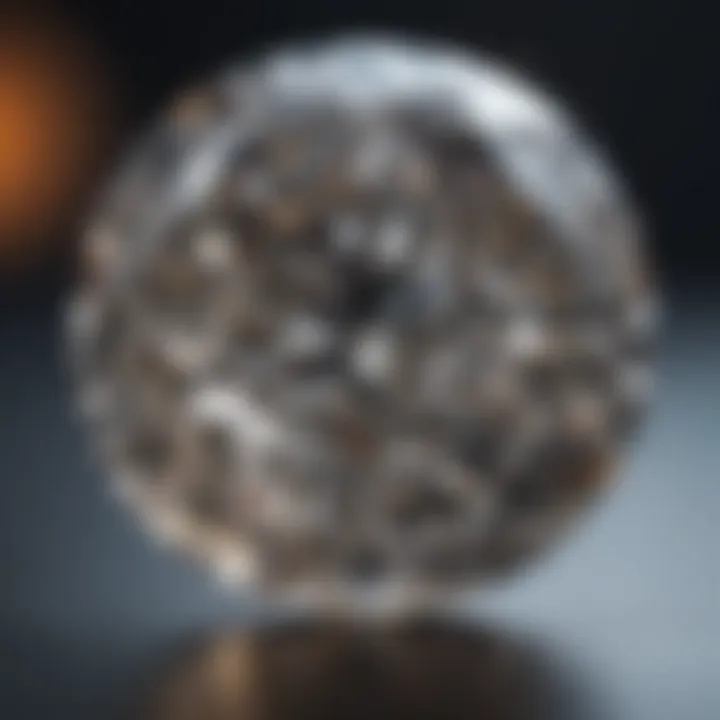
Intro
Understanding the value of a 200 carat diamond is not a simple task. The worth of such an oversized gemstone can vary greatly. Factors influencing this include the diamond's quality, market trends, and its rarity. This section aims to set the stage for a deeper exploration of these dynamics. It will lead to insights that can help collectors, investors, and enthusiasts appreciate the complexities involved in evaluating these luxurious gems.
Gemstone Overview
Definition of Gemstones
Gemstones are naturally occurring minerals or rocks that are cut and polished for jewelry and decorative purposes. While many gemstones are valued for their beauty, their worth can also be influenced by their rarity and durability. A diamond, particularly one weighing 200 carats, falls into this category due to its unique properties and aesthetic appeal.
Classification of Gemstones
Understanding gemstones involves recognizing how they are classified. Generally, they are divided into two main categories: precious and semi-precious.
- Precious Gemstones
These are the most sought-after gems, including diamonds, rubies, emeralds, and sapphires. Their value is often dictated by their rarity and demand. - Semi-Precious Gemstones
This group encompasses a wider range of gemstones, such as amethysts, garnets, and aquamarines. Although they may lack the extreme rarity of precious stones, many semi-precious gems are still valued highly, depending on their quality.
Historical Significance
Origins of Gemstone Use
The use of gemstones dates back thousands of years. Early civilizations treasured these materials for their beauty and believed they had mystical or healing properties. The fascination with gemstones, including diamonds, has persisted through the ages, often intertwined with cultural significance.
Cultural Insights: Gemstones in Ancient Civilizations
In ancient civilizations, gemstones were not merely objects of adornment. Their significance can be seen in various cultures:
- Egyptians used stones like turquoise and lapis lazuli as symbols of power and protection.
- Greeks associated gems with the divine and wore them as talismans.
- Indians attributed astrological meanings to certain stones, influencing societal structures.
"The historical context of gemstones provides insight into their perceived value, which often transcends mere aesthetics."
These cultural connections continue to inform our understanding of diamonds today, especially in how we evaluate magnificent specimens like a 200 carat diamond.
Understanding Carat Weight
Understanding carat weight is crucial when evaluating the value of diamonds, especially those weighing around 200 carats. Carat weight provides a direct measure of the size of a diamond, but its implications extend far beyond mere dimensions.
In the diamond market, size is a primary factor influencing perceived value. Many buyers equate larger diamonds with greater worth, regardless of other quality factors. Therefore, grasping the nuances of carat weight can help collectors and investors make informed decisions.
Definition of Carat
Carat is a unit of weight used to measure gemstones, including diamonds. One carat is equivalent to 200 milligrams. This measurement is crucial as it directly impacts the price of a diamond. The higher the carat weight, the more substantial the diamond.
However, it is vital to remember that carat weight does not directly translate to size; this can be influenced by the diamond’s cut. For instance, a well-cut diamond might appear larger than a poorly cut diamond of the same carat weight.
The weight becomes more significant in larger stones. For a diamond weighing at least 200 carats, even slight differences in weight can result in substantial price variations. This makes understanding carat an essential aspect of purchasing or appraising a large diamond.
Significance in Diamond Valuation
Carat weight significantly affects diamond valuation. In fact, the price per carat often increases with size. This is due to the rarity of larger diamonds, which makes them more desirable to collectors and investors.
Considerations for valuation include:
- Market Demand: Larger diamonds are often in higher demand, creating a premium for those stones.
- Rarity: As carat weight increases, the availability of high-quality diamonds decreases. This rarity complicates the valuation process, often leading to heightened prices.
- Quality Correlation: While larger diamonds may be alluring, their overall valuation must incorporate the Four Cs. Cut, color, and clarity all play vital roles alongside carat weight.
"Understanding carat weight can demystify the process of valuing large diamonds, enabling smarter investment decisions."
In summary, carat weight is more than a simple measurement. It is an intricate element that blends with various other factors to define a diamond's overall worth. Hence, for anyone thinking about investing in or admiring a 200 carat diamond, understanding its carat weight is truly indispensable.
The Four Cs of Diamond Quality
Understanding the Four Cs is essential when evaluating the value of any diamond, particularly one as substantial as a 200 carat diamond. The Four Cs consist of Cut, Color, Clarity, and Carat weight. Each of these elements contributes significantly to the overall quality and, consequently, the value of the diamond. Misunderstanding any aspect can lead to poor investment decisions. Therefore, a comprehensive grasp of these factors is important for gemstone enthusiasts, collectors, and investors alike.
Cut
The cut of a diamond refers to how well it has been shaped and facets created. This aspect heavily influences the diamond's sparkle and overall aesthetic. A well-cut diamond reflects and refracts light effectively, making it appear more brilliant. On the other hand, a poorly cut diamond may appear dull or lifeless, even if it possesses superior color or clarity.
When examining a 200 carat diamond, the cut is particularly critical. The artistry involved in crafting such a large stone requires skill and precision. A diamond that is cut too shallow or too deep can lose significant light, decreasing its value. Additionally, certain cuts may be more favorable based on current market trends, making it necessary to stay informed.
Color
Color is another vital factor in diamond valuation. Traditionally, diamonds are valued on a scale from D (colorless) to Z (light yellow or brown). Colorless diamonds tend to be more sought after and can command higher prices. Diamonds that display no hue are rarer and are typically perceived as more valuable.
For a 200 carat diamond, the color can greatly affect its worth. A larger stone may show color more prominently than a smaller one. Thus, a J or K color rating in smaller diamonds might be less significant, but the same ratings can diminish the value of a large diamond sharply.
Clarity
Clarity refers to the presence of internal or external imperfections, often referred to as inclusions and blemishes. The clarity scale ranges from Flawless (no inclusions or blemishes visible under 10x magnification) to Included, where imperfections can be seen with the naked eye.
For a diamond of 200 carats, clarity is paramount. Any visible flaws can significantly decrease its aesthetic appeal and market value. Collectors will be particularly sensitive to this, as many will prioritize stones with minimal inclusions. The clarity assessment thus needs to be thorough and precise, as small imperfections are more noticeable on larger stones.
Carat Weight
Carat weight indicates the size of the diamond; one carat equals 200 milligrams. However, the value of a diamond increases exponentially with its weight. A 200 carat diamond is exceptionally rare and desirable, not just because of its size but also due to the complexities involved in its cutting and setting.
While large diamonds attract attention and often demand higher prices, carat weight alone does not determine a diamond's value. The interplay between the Four Cs ensures that only a diamond that excels in all areas can reach its true worth. Thus, a comprehensive understanding of carat weight relative to cut, color, and clarity is necessary for informed investment choices.
"Successful diamond evaluations integrate all Four Cs seamlessly to reveal a stone's true potential."
Market Conditions Affecting Diamond Prices
Global Economic Factors
Global economics play a vital role in determining diamond prices. When economies are thriving, luxury goods such as diamonds tend to see a rise in demand. Increased disposable income allows consumers to spend more on high-value items. Conversely, during recessions, the demand for luxury items diminishes. Economic indicators such as GDP growth, unemployment rates, and consumer confidence indices are key metrics to observe.
Here are some key global economic factors that affect diamond prices:
- Consumer Spending Power: Increased spending power leads to higher sales of luxury goods.
- Inflation Rates: High inflation can erode consumer purchasing power, negatively impacting luxury sales.
- Currency Strength: A strong currency may make diamonds more expensive in foreign markets, which influences international sales.
- Political Stability: Countries with stable political environments attract higher investments and luxury spending.
These interconnected factors demonstrate how essential it is to monitor global economic conditions when valuing a diamond in today's market.
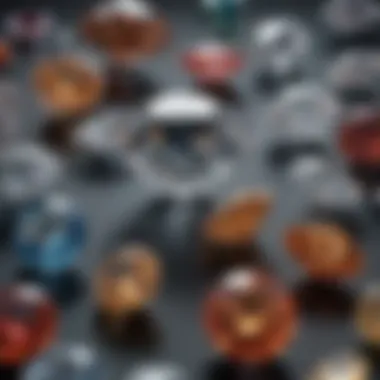

Supply and Demand Dynamics
The principles of supply and demand are fundamental in the diamond industry, especially for large gemstones like a 200 carat diamond. A limited supply of diamonds combined with high demand increases value. Conversely, if a large number of prestigious diamonds enter the market, prices could fall.
- Supply Factors:
- Demand Factors:
- Mining Output: Reduction in mining activities or the discovery of new reserves can affect supply.
- Quality of Supply: Superior quality diamonds are always in limited supply, thereby elevating their prices.
- Trends in Jewelry: Changes in what consumers want in jewelry can impact demand.
- Investment Demand: Increasingly, diamonds are viewed as an alternative investment, affecting their market value.
Ultimately, the interaction between supply and demand creates the framework within which diamond prices fluctuate. As such, one must remain aware of market trends and consumer behavior, especially in the luxury sector, as they directly influence the valuation of high-carat diamonds.
The Role of Certification in Diamond Valuation
The significance of certification in diamond valuation cannot be understated. A certified diamond comes with a report from a recognized laboratory, providing an assessment of significant attributes such as cut, color, clarity, and carat weight. This validation is crucial in the context of high-value diamonds, especially those weighing 200 carats or more, where the stakes of misvaluation are notably higher. Buyers look for assurance in the diamond's quality, and certification provides a structured means to achieve that confidence.
Recognized Certification Bodies
A few key certification bodies dominate the landscape in the diamond appraisal industry. Among them, the Gemological Institute of America (GIA), the American Society of Appraisers (ASA), and the International Gemological Institute (IGI) are highly regarded. Each of these organizations applies stringent standards to their evaluation processes. For instance, the GIA's grading system is widely accepted as the benchmark; they focus on scientific methods and impartiality.
- Gemological Institute of America (GIA) - Best known for its comprehensive grading criteria and research in gemology.
- American Society of Appraisers (ASA) - Offers specialized training in appraisal techniques focused on credibility and ethics.
- International Gemological Institute (IGI) - Provides a broader set of services, emphasizing accessibility for both buyers and sellers.
These institutions enhance the credibility of diamonds they certify, which in turn affects buyer trust and perception in the market. When a diamond has a GIA certification, for example, it is generally associated with a higher resale value due to reliable grading standards, influencing buyers' choices significantly.
Importance of Certification in Pricing
Certification has a direct impact on diamond pricing. When a diamond is evaluated by a trusted authority, it assures potential buyers of its quality and authenticity, which can elevate its market value. The certified grades attached to a diamond serve as a baseline for pricing, making it easier to compare with other similarly graded stones.
Moreover, a lab-certified diamond reduces the potential for disputes regarding quality since both buyer and seller have a mutual understanding of the stone's attributes. This transparency can be particularly important in auction scenarios or private sales, where diamonds of high value may experience volatility in pricing due to lack of consensus.
In summary, certified diamonds tend to hold their value better and command higher prices than their non-certified counterparts.
Investing in diamonds, especially those exceeding 200 carats, requires having clarity in all aspects, and certification becomes the cornerstone of that clarity. Buyers are encouraged to seek out certified stones to ensure they are investing wisely.
Historical Context of Large Diamonds
Understanding the historical context of large diamonds provides valuable insights into their significance, pricing, and desirability in contemporary markets. Throughout history, diamonds have served not only as adornments but also as symbols of power and wealth. The story of large diamonds is one entwined with stories of royalty, conquests, and shifts in societal values. This section delves into how these historical narratives shape the understanding of today’s diamond market and influence the valuation of exceptionally large stones.
Significant Historical Diamonds
Several historical diamonds exemplify the prestige associated with large gemstones. Examples such as the Koh-i-Noor and the Cullinan Diamond are crucial to comprehension.
- Koh-i-Noor: This 105.6 carat diamond originated in India and has a storied past involving numerous owners, including Persian and Mughal emperors. Currently, it resides in the Tower of London as part of the British Crown Jewels. Its rich heritage contributes to its immense market value and symbolic significance.
- Cullinan Diamond: Weighing over 3,000 carats initially, it was discovered in South Africa in 1905. The diamond was cut into several famed stones, including the Cullinan I, also known as the Great Star of Africa, which is set in the British Royal Sceptre. The Cullinan's significance as the largest gem-quality diamond ever found adds to its allure and influences the market's perspective on large diamonds today.
These diamonds are not merely gemstones; they embody narratives of empire, culture, and the unyielding allure of precious stones. They set precedence for what large diamonds can represent and the prices they can command.
Evolution of Market Perception
The perception of large diamonds has undergone notable transformation over the centuries. Previously, size was often considered the most critical factor in determining a diamond's value.
However, this trend has evolved considerably. Today, connoisseurs and investors also emphasize quality indicators such as cut, color, and clarity. These Four Cs play a significant role in how large diamonds are appraised and marketed.
Factors influencing this shift include:
- Cultural Shifts: As society evolves, so do tastes and standards regarding beauty and value. The contemporary consumer often seeks unique gems rather than just large stones.
- Increased Knowledge: The rise of gemological science has facilitated a deeper understanding of diamond characteristics. This has propelled buyers to consider detailed evaluations and certifications over mere size.
- Economic Fluctuations: Periods of economic downturn have influenced the diamond market. During these times, buyers often prioritize diamonds that offer strong investment potential, which can lead to a preference for quality over size.
Therefore, while the allure of a large diamond remains, its value is increasingly defined by a combination of historical significance, craftsmanship, and modern market dynamics. > Understanding the historical context enriches the appreciation of large diamonds, illustrating their continuous evolution and the factors that feed into their valuation today.
Comparative Analysis of High-Value Diamonds
The comparative analysis of high-value diamonds is a crucial aspect of understanding the diamond market. It provides insights into how individual stones can vary greatly in worth, depending on various factors. By examining notable auctions and specific case studies of 200 carat diamonds, we can grasp the significance of rarity, quality, and market demand. This analysis not only informs potential buyers and investors but also helps collectors appreciate the value of their gems in the broader context of diamond valuation.
Notable Auctions and Their Results
Auctions featuring high-value diamonds often serve as benchmarks for the current market. Notable auction houses like Sotheby’s and Christie’s frequently conduct sales that showcase extraordinary gems. For instance, the sale of the Pink Star at Sotheby’s in 2017 for $71.2 million highlighted how color, size, and history can elevate a diamond’s value.
- Key Factors in Auction Prices:
- Rarity: Unique traits can drive up interest and bids.
- Historical Significance: Provenance can add to a diamond's allure.
- Market Trends: Economic conditions can impact bidding behaviors.
These auction results not only reveal the amount buyers are willing to pay but also offer a glimpse into the evolving preferences within luxury markets. Participation in these events can provide investors a clearer picture of value trajectories among high-value diamonds.
Case Studies of Carat Diamonds
Examining specific case studies of 200 carat diamonds helps to contextualize their valuation. Notable examples include the Imperial Green jadeite diamond and the Blue Moon Diamond, which both captured significant attention.
- Imperial Green Jadeite Diamond:
This remarkable stone, weighing 200 carats, sold for over $8 million. Factors such as its deep green color and clarity contributed to its high valuation. - Blue Moon Diamond:
Weighing slightly below 200 carats, this diamond fetched $48.4 million at auction. Its vivid blue color and rare characteristics set it apart in the market.
By understanding these cases, enthusiasts can see how the elements of color, size, and individual history influence the precious gem market.
"A 200 carat diamond does not only reflect its weight; it often embodies stories of luxury, status, and investment potential."
Thus, comparative analysis of high-value diamonds acts as a vital tool for anyone looking to navigate the complexities of this market.
Investment Considerations for Large Diamonds
Investing in large diamonds, specifically those weighing around 200 carats, requires a deep understanding of several interrelated factors. The value of these stones can be significantly affected by market perceptions, rarity, and intrinsic qualities like the Four Cs. It is crucial to analyze these elements to gauge the true potential of a diamond investment.
Additionally, the complexities surrounding large diamonds establish a unique investment narrative. Considering the factors that influence liquidity, marketability, and long-term value retention is essential for a well-rounded investment approach. Only informed buyers can navigate the expansive landscape of high-value diamonds effectively.
Liquidity and Marketability
Liquidity refers to how quickly an asset can be sold without causing a significant drop in its value. In the context of 200 carat diamonds, liquidity presents unique challenges. These diamonds may not sell quickly or easily, especially if the seller demands a specific high price, which can be at odds with market conditions.
Marketability also ties closely to liquidity. A diamond's appeal can hinge on current trends, preferences among collectors, and the overall economic climate. For instance, a 200 carat diamond that is exceptionally cut and certified by a well-recognized body may command more attention and fetch higher bids at auctions. Consequently, one should focus on the following factors:
- Certification: Accreditation from reputable organizations like the Gemological Institute of America enhances market value and liquidity.
- Demand: The desirability of specific styles and qualities at a given time can dramatically influence how quickly a diamond can be sold.
- Condition and Provenance: A diamond's history, including previous ownership or notable events surrounding it, can add value.
Understanding these factors are vital for potential investors who want to gauge their capacity to liquidate their diamonds when necessary, without a severe loss.


Long-term Value Retention
Long-term value retention speaks to a diamond's ability to maintain or grow in value over an extended period. Unlike some assets that may experience volatility and rapid changes, rare diamonds often exhibit a more stable appreciation rate, especially if stored and handled properly.
Investors should consider several aspects for long-term retention:
- Quality: High-quality diamonds typically retain value better than lesser quality stones. The Four Cs—cut, color, clarity, and carat—play a significant role in determining intrinsic value.
- Rarity: A 200 carat diamond is already uncommon. Its rarity increases if it has exceptional qualities or unique features.
- Market Trends: Being aware of market trends through research can reveal potential appreciation trajectories over time, allowing investors to strategize accordingly.
Investing in diamonds is not just about immediate financial returns but also about understanding the broader context of the gemstone market.
In summation, understanding both liquidity and long-term retention is essential for investors in large diamonds. Their perceived value can fluctuate, but informed decisions about purchase and potential resale can significantly affect investment outcomes.
Practical Aspects of Purchasing a Carat Diamond
Acquiring a 200 carat diamond is an elaborate endeavor. Understanding the practical aspects involved in purchasing such a significant gemstone is crucial for any serious buyer. This section unfolds the essential elements to consider, including where to buy and the necessary verification processes. The implications of making an informed decision in this market cannot be overstated. Such a purchase can represent not only a personal investment but also a choice that signifies status and appreciation for fine craftsmanship.
Where to Buy
When searching for a 200 carat diamond, selecting the right venue is paramount. Buyers have a few primary options: reputable jewelers, auction houses, and online platforms tailored for high-value gemstones.
- Reputable Jewelers: Well-known stores often provide certified diamonds with an assurance of quality and authenticity. These jewelers have built trust over the years, making them a safe choice.
- Auction Houses: Prestigious auction houses, like Sotheby's and Christie's, specialize in valuable diamonds. Here, buyers can find rare pieces, often with an extensive provenance.
- Online Platforms: Several online retailers also cater to high-end customers. Sites such as Blue Nile offer a wide range but require careful evaluation of sellers' credentials.
Each avenue has its own merits and risks. Given the size of a 200 carat diamond, conducting thorough background checks on the seller is non-negotiable.
Verification Processes
To ensure the diamond's authenticity and quality, verification should never be overlooked. Prospective buyers should engage in a comprehensive verification process. This includes:
- Certification: Always request a certificate from recognized bodies like the Gemological Institute of America (GIA) or the International Gemological Institute (IGI). These documents detail the quality of the diamond, including its cut, color, clarity, and carat weight.
- Independent Appraisal: Consider obtaining an appraisal from a qualified gemologist. An unbiased expert can provide insight into the diamond's true value and quality.
- Visual Inspection: If possible, inspect the diamond personally or through expert assistance. This includes checking for any visible inclusions or flaws.
"The best diamonds come with verified documentation to support their value. This not only ensures fairness in pricing but also earns buyer confidence."
Implementing these verification processes can prevent costly mistakes and ensure that the stone purchased meets expectations.
Synthetic and Natural Diamonds: A Value Comparison
The distinction between synthetic and natural diamonds has gained prominence in recent years. This comparison is crucial not only for collectors but also for investors evaluating a 200 carat diamond. Understanding the differences in market perception and valuation is vital, as it influences buying decisions and investment strategies. Moreover, these differences reflect on the broader diamond market and consumer preferences, thus impacting long-term value retention.
Market Perception of Synthetics vs. Naturals
Synthetic diamonds, also known as lab-created diamonds, are chemically identical to natural diamonds but are created in controlled environments. While they offer a more affordable option for consumers, their perception in the market differs greatly from their natural counterparts.
Many consumers still view natural diamonds as the symbol of luxury and rarity. This perception often elevates the status of natural diamonds, regardless of their size or visual appeal.
- Emotional Value: Natural diamonds carry emotional weight and a sense of history that synthetics often lack.
- Rarity: Because natural diamonds are formed over millions of years, their scarcity adds to their allure and perceived value.
Conversely, synthetic diamonds offer certain benefits that appeal to a segment of consumers:
- Affordability: They can be significantly less expensive while having similar optical properties.
- Ethical Concerns: Many consumers favor synthetics for their eco-friendly attributes, as they do not incur the same environmental costs as natural diamond mining.
In recent years, some luxury brands have begun to incorporate synthetic diamonds into their collections, which further complicates the market dynamics. Their acceptance by high-end jewelers legitimizes them but also competes directly with natural stones.
"Understanding the nuances in market perception of synthetic and natural diamonds can greatly influence investment decisions. A well-informed buyer is more likely to make a satisfactory purchase."
Impact on Valuation
The valuation of synthetic and natural diamonds varies widely based on market conditions and consumer preferences. Generally, natural diamonds retain a higher value due to their rarity, while synthetic diamonds are often viewed as a commodity, leading to different pricing structures.
- Depreciation in Value: Synthetic diamonds tend to depreciate quickly after purchase. Their value can drop significantly compared to natural diamonds, which often appreciate or hold value over time.
- Market Demand: The supply of synthetic diamonds continues to rise, potentially saturating the market. An oversupply can impact prices negatively.
In appraising a 200 carat diamond, one must consider these factors:
- Size: Larger natural diamonds can command exponentially higher prices than smaller synthetics.
- Certification: Certified natural diamonds from recognized gemological organizations typically have higher appraisal values.
- Consumer Trends: Tracking trends is essential. Increasing acceptance of synthetic stones could shift their valuation upwards, but natural diamonds likely will continue to dominate the luxury market.
Technology's Impact on Diamond Valuation
The influence of technology in the realm of diamond valuation represents a vital area of modern gemology. With advancements in tools and techniques, both the assessment and transparency of diamond quality have improved significantly. This section delves into how technology has reshaped the methods for evaluating diamonds, especially large stones like a 200 carat diamond.
Emerging Technologies in Gemology
In gemology, several emerging technologies are revolutionizing how diamonds are evaluated. These technologies provide greater accuracy and clarity in assessing the qualities of diamonds. Key innovations include:
- 3D Imaging: Advances in imaging techniques allow for detailed visualizations of diamonds. This enables appraisers to assess the stone's cut and clarity more effectively.
- Spectroscopy: This technology helps identify impurities and the diamond's origin. Spectroscopic analysis can determine if a diamond is natural or synthetic, which is crucial for valuation.
- AI and Machine Learning: These technologies are being used to automate appraisal processes, providing consistency and reducing human error. Algorithms can analyze various attributes of diamonds and predict market pricing trends.
These technologies enhance the objectivity of evaluations while also streamlining the certification process. With reliable technological methods, buyers can make more informed decisions when investing in high-value diamonds.
Valuation Tools and Techniques
A variety of tools and techniques developed through technology play essential roles in evaluating the value of diamonds:
- Precision Scales: Digital scales specifically designed for gemology ensure accurate carat weight measurements, which is fundamental in the valuation process.
- Refractometers: These devices measure the refractive index of diamonds, providing valuable information regarding clarity and cut.
- Light Performance Tools: Devices like the gemologist's viewer can assess light return and brilliance of the diamond, which directly influences its value.
These tools facilitate a comprehensive understanding of a diamond's characteristics. For example, light performance can dramatically affect a diamond's aesthetic appeal, thus impacting its market value.
"Technology not only enhances the precision of evaluations but also helps maintain consumer confidence in the diamond market."
In summary, the integration of technology into diamond valuation is reshaping the landscape of the gemstone market. As technology continues to advance, it will likely further refine how experts appraise large diamonds, resulting in ongoing changes in consumer trust and market dynamics. Understanding these trends is crucial for collectors and investors looking to navigate the complexities of high-value diamond acquisitions.
Cultural Significance of Large Diamonds
Large diamonds possess a unique status that goes beyond their material value. They often symbolize wealth, power, and beauty across various cultures. The significance of these gemstones is multifaceted, reflecting deep-rooted societal values and traditions. Understanding this cultural importance can enhance our appreciation of 200 carat diamonds as not just luxury items but integral elements of human history and social expression.
One of the essential elements of this cultural appreciation lies in the symbolism attributed to diamonds. Many cultures view diamonds as a representation of eternal love and commitment. This is particularly evident in engagement rings, where large diamonds are particularly sought after. Their rarity and beauty elevate their status, making them ideal tokens of significant life events. In many societies, gifting a diamond carries profound meaning, often signifying devotion or status.
Moreover, large diamonds often find themselves at the center of myth and folklore. They are seen as a source of protection and prosperity in various cultures. For example, some African tribes believed that diamonds had magical properties, capable of bringing good fortune and warding off evil spirits. This illustrates how large diamonds are integrated into the fabric of cultural narratives, influencing rituals and celebrations.
Additionally, diamonds reflect the aspirations of individuals and societies. People often aspire to own or wear these gemstones as achievements of personal or societal success. This association further entrenches their standing as symbols of affluence and prestige. Given the intricate interplay of cultural values and diamond ownership, it is crucial to recognize these larger implications when evaluating a diamond's worth.
Large diamonds often transcend mere adornment; they weave into the very identity of individuals and cultures. Their value is multidimensional, encompassing emotional, historical, and social layers.
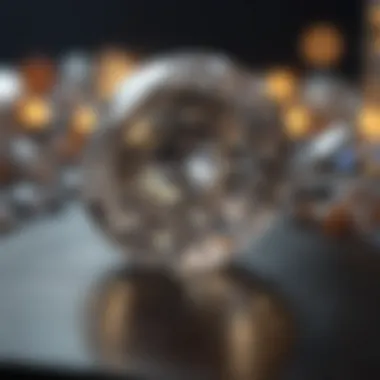
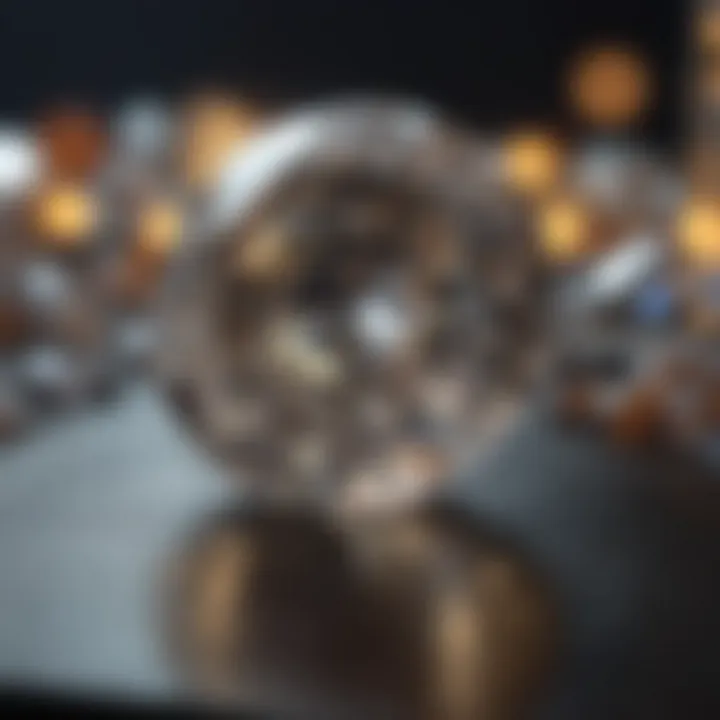
Symbolism in Different Cultures
The symbolism of diamonds varies significantly across cultures. In Western societies, diamonds are primarily known as symbols of love and commitment. The tradition of diamond engagement rings is a prime example, where a large diamond signifies the depth of one’s emotional commitment. In contrast, in some Eastern cultures, diamonds are considered protective stones. They are believed to bring good luck and fortune, lending them a sacred quality.
In India, diamonds have been cherished for centuries. Historically, they were adorned by royalty and regarded as symbols of invincibility. They also appear in various religious practices and are believed to enhance spiritual completeness. In contrast, Western perceptions focus more on love and romance, showing how cultural narratives shape our understanding of these gemstones.
Influence on Popular Culture
Diamonds have long held sway in popular culture, becoming emblematic of wealth and success. Films, music, and literature often depict diamonds as the ultimate prize. This cultural portrayal helps cement their status as not just valuable possessions, but as symbols of lifestyle and aspiration.
For example, the famous saying "Diamonds are a girl’s best friend" reflects a viewpoint that continues to influence consumer behaviors. This sentiment resonates especially in luxury advertising, which often links diamonds with a glamorous lifestyle. Large diamonds are frequently featured at high-profile events, reinforcing their image as objects of lavishness. The presence of diamonds in red carpet events only elevates their desirability, making them synonymous with ultimate success.
The ongoing fascination and admiration for large diamonds can also be observed in reality television and celebrity culture. People remain captivated by the extravagant diamonds worn by public figures, providing a benchmark for wealth and success in modern society. This illustrates how cultural narratives continue to evolve, maintaining diamonds' relevance in contemporary discussions about luxury and value.
Ethical Considerations in Diamond Sourcing
The ethical considerations in diamond sourcing play a pivotal role in contemporary discussions about high-value diamonds. With growing awareness of social and environmental issues, consumers increasingly seek diamonds that reflect ethical practices. The implications of this trend are profound, influencing buyer preferences, pricing structures, and even the nature of diamond sourcing itself.
Understanding Conflict-Free Diamonds
The term "conflict-free diamonds" signifies gems that are sourced from mines not involved in financing violence or human rights abuses. In certain regions, particularly in Africa, the diamond trade has fueled conflict and exploitation. Thus, the Kimberley Process, established in 2003, aims to prevent these conflict diamonds from entering the market. Many high-end buyers and collectors now prioritize conflict-free stones. This growing emphasis contributes to transparency in the diamond industry. Buyers feel more confident knowing that their purchases do not support unethical practices.
Organizations and certification bodies ensure strict adherence to these standards. Among them, the Responsible Jewelry Council enforces ethical sourcing practices. When considering a 200 carat diamond, verifying its conflict-free status is essential. Trustworthy retailers often provide documentation that validates the diamond's ethics, ensuring peace of mind for concerned buyers.
Sustainability Trends in the Diamond Industry
Sustainability is emerging as a critical factor in the diamond trade. Concerns over the environmental impact of mining operations lead many to advocate for more sustainable practices. This trend encompasses various aspects, including reducing land disruption, conserving water, and minimizing carbon emissions during extraction.
Some companies are exploring innovative methods to source diamonds sustainably. For example, some have turned to lab-grown diamonds, which provide an ethical alternative without compromising on quality. They offer a substantial reduction in the ecological footprint compared to traditional mining processes.
Consumer awareness is rapidly increasing regarding the ecological implications of diamond sourcing. Many now actively seek brands that prioritize sustainable practices. Such trends not only impact consumer choices but also drive changes in the broader diamond industry. As sustainability becomes a focal point, it is increasingly likely that more retailers will adopt ethical sourcing measures.
The shift towards conflict-free and sustainable diamonds seems not just a trend but a necessary evolution within the gem industry.
The Future of Large Diamonds in the Market
The market for large diamonds is under continuous evolution, shaped by shifting consumer attitudes, economic factors, and advancements in technology. Understanding the future of these stones is vital for collectors and investors. This section explores the primary components shaping the future landscape for large diamond transactions and valuations.
Trends in Consumer Preferences
In recent years, consumer preferences have displayed significant shifts. Younger buyers increasingly focus on sustainability and ethical sourcing. This demographic values transparency and often prefers diamonds that come with a clear history. In this regard, conflict-free diamonds have gained traction.
Moreover, there is an uptick in interest in unique and vintage stones, as opposed to traditional, standard cuts. Gemstone enthusiasts are seeking out diamonds that tell a story or showcase distinct characteristics. This variation in demand influences supply channels and market pricing. As consumers become more selective, only diamonds that align with these values will maintain or even increase in value.
Predictions for Value Changes
Forecasting the value of large diamonds is more intricate than it may appear. Several factors contribute to potential shifts in worth. Economic conditions, such as inflation and disposable income levels, can significantly impact luxury purchases, including high-value diamonds.
Another variable is the growing market for lab-grown diamonds. As these become more accepted, there may be a consequence for natural diamond values, particularly for larger stones. The market might see a balancing act between maintaining demand for traditional diamonds versus an inclination towards newer options.
Practical Guidance for Appraising a Carat Diamond
Appraising a 200 carat diamond is a complex endeavor that necessitates a structured approach. Without appropriate guidance, one can easily overlook critical factors impacting the diamond's value. Given the high stakes involved in such a hefty investment, understanding this guide's nuances can be invaluable for gemstone enthusiasts, collectors, and jewelry designers alike.
When evaluating a diamond of this scale, one must consider multiple aspects. The first step involves assessing quality and value through the Four Cs: cut, color, clarity, and carat weight. Each element contributes cumulatively to the diamond's overall worth. Additionally, external elements such as market dynamics and certification play crucial roles in forming an accurate appraisal.
The benefits of obtaining a thorough appraisal extend beyond just understanding value. A detailed assessment ensures proper alignment of expectations regarding pricing. Furthermore, it aids in deciding on resale options or future investments. The importance of engaging with professional appraisers cannot be understated. Their expertise can illuminate specific aspects of the diamond that may not be immediately apparent, hence enriching the overall evaluation process.
In summary, having practical guidance for appraising a 200 carat diamond is indispensable for anyone looking to invest wisely in such a remarkable gemstone. By consciously navigating the complexities involved, collectors can ensure their choices stand on solid ground and enhance their investment's potential.
Assessing Quality and Value
Assessing quality and value usually encompasses not just a basic look at the diamond but also a thorough inspection of its unique features. When appraising a diamond, attention should be directed to:
- Cut quality: A well-cut diamond reflects light exquisitely. Poor cuts can diminish visual appeal significantly.
- Color grading: Diamonds come in a variety of colors, where colorless stones are typically valued higher.
- Clarity levels: The presence of inclusions or blemishes can affect a diamond's desirability and, consequently, its price.
- Carat weight: For a 200 carat diamond, it's essential to understand how this weight influences value compared to smaller stones.
Successful appraisal requires both technical knowledge and market understanding. Misunderstanding these criteria can lead to significant financial missteps.
Engaging with Professional Appraisers
Engaging with professional appraisers offers tremendous advantages. These specialists often bring extensive experience and knowledge that can provide a more accurate appraisal than a layperson might achieve. Here are some key reasons to consider professional help:
- Expertise: Appraisers are trained to recognize subtleties that can heavily influence value.
- Certification: Many appraisers are linked with recognized certification bodies, ensuring their evaluations are credible.
- Market insights: Professionals can offer current market trends that optimize sale potential.
- Documentation: A professional appraisal includes documents essential for insurance and future resale.
Utilizing professional appraisers mitigates risk by grounding decisions in well-informed evaluations. Their insights can provide clarity in what may initially seem like a daunting appraisal process.
Understanding the nuances of appraising a diamond is essential to safeguard your investment. A professional appraiser can make all the difference.
End on the Value of a Carat Diamond
In assessing the value of a 200 carat diamond, it is crucial to recognize the various factors at play. These diamonds do not just represent size; they embody a complex interplay of quality, rarity, and market dynamics. The price can fluctuate widely based on the nuances of the Four Cs—cut, color, clarity, and carat weight. Additionally, market conditions, such as consumer demand and economic factors, play significant roles in valuation.
Moreover, the role of certification cannot be understated. Diamonds backed by reputed certification bodies instill confidence in buyers, helping them to easily gauge the quality and worth of the gem. As the market evolves, understanding the implications of these assessments becomes vital for anyone looking to make informed decisions.
The trends of consumer preferences also merit attention. There is a growing consciousness around sustainable and ethical sourcing of diamonds. This shift impacts how potential buyers evaluate the merits of a diamond purchase, especially for high-value stones like a 200 carat diamond.
Thus, this conclusion gathers the essential insights from this article, allowing readers to comprehend not only the technical aspects but also the broader implications of owning such a significant gemstone.
Key Takeaways
- Quality Matters: The value of a 200 carat diamond hinges on the Four Cs: cut, color, clarity, and carat weight.
- Market Influence: External factors like global economic conditions and consumer demand affect diamond prices significantly.
- Certification Significance: Trusted certification plays a key role in establishing trust and verifying the value of diamonds.
- Consumer Trends: Increasing preference for ethically sourced diamonds is altering the market landscape.
- Investment Considerations: Prospective buyers must assess not just immediate value but long-term growth potential in their investments.
Final Thoughts on Investment Potential
Investing in a 200 carat diamond can be both exhilarating and daunting. The unique characteristics and potential appreciation of large diamonds captivate collectors and investors alike. However, it requires informed decision-making. Prospective buyers need to understand that larger diamonds typically command higher prices but may also carry more risks associated with liquidity and resale.
Monitoring the market and staying updated on trends can lead to successful investment outcomes. Additionally, engaging with professional appraisers and relying on credible certification can enhance the confidence in one’s purchase.
In summary, while the allure of a 200 carat diamond is undeniable, careful consideration and thorough due diligence are paramount for making wise investments.
Citations for Further Reading
For readers interested in further expanding their knowledge on the valuation of diamonds and related subjects, the following sources are highly recommended:
- Wikipedia offers broad overviews on gemological terms and famous historical diamonds. This can help contextualize the significance of carat weight and larger stones in general. Wikipedia
- Britannica provides refined and researched articles that delve into gemology, enhancing your understanding of the science behind diamonds. Britannica
- Reddit is a platform where enthusiasts discuss trends, valuation techniques, and personal experiences with gemstones. It's worth exploring various threads for contemporary insights. Reddit
- Facebook has groups dedicated to collectors and gem enthusiasts that can serve as a peer resource for sharing information and insights about diamond values. Facebook



